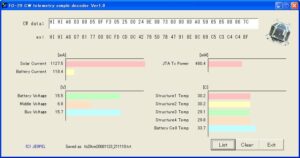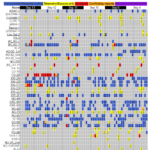AMSAT NEWS SERVICE
ANS-272
The AMSAT News Service bulletins are a free, weekly news and information service of AMSAT North America, The Radio Amateur Satellite Corporation. ANS publishes news related to Amateur Radio in space including reports on the activities of a worldwide group of Amateur Radio operators who share an active interest in designing, building, launching and communicating through analog and digital Amateur Radio satellites.
The news feed on https://amsat.org publishes news of Amateur Radio in space as soon as our volunteers can post it. Please send any amateur satellite news or reports to: ans-editor at amsat dot org. You can sign up for free e-mail delivery of the AMSAT News Service Bulletins via the ANS List; to join this list see: https://www.amsat.org/mailman/listinfo/ans
In this edition:
- Experimenter Wednesday Announced for AO-92
- The AMSAT Hamfests & Conventions Web Page Updates
- 2019 37th AMSAT Space Symposium and Annual General Meeting
- 2019 AMSAT Symposium On-line Registration Open Until October 11
- Virgin Orbit’s LauncherOne Moves Another Step Closer to Flight
- ARISS Activities & Upcoming ARISS Contact Schedule
- Upcoming Satellite Operations
- NASA’s International Space Apps Challenge Coming October 18-20
- FO-29 Returns!
- AMSAT-DL Memorandum Regarding QO-100 Operation
- Satellite Shorts From All Over
Experimenter Wednesday Announced for AO-92
The AO-92 Command Team announces that Experimenter Wednesday will run on UTC Wednesday (begins Tuesday evening in North America) when AO-92 will be commanded to operate in mode L/v for 24 hours. This new schedule will be followed for an as of yet undetermined test period.
The frequencies for AO-92 L/V are:
| AO-92 Mode L/V Operation | ||
|---|---|---|
| Uplink | 1267.359 MHz | FM with 67 Hz CTCSS tone for access |
| Downlink | 145.880 MHz | Including DUV telemetry |
The mode change is announced by the command team via Twitter (follow @AMSAT). You can view AMSAT tweets without needing an account with Twitter – go to https://twitter.com/AMSAT
The tweets flow through to the AMSAT facebook page and are planned to include amsat-bb. Also current status can be found on the AO-92 health and telemetry page at: http://www.amsat.org/tlm/health.php?id=4&port=
[ANS thanks the AO-92 Command Team for the above information]
The AMSAT Hamfests & Conventions Web Page Updates
 Information about AMSAT activities at important events around the country is posted on the AMSAT Hamfests & Conventions web page:
Information about AMSAT activities at important events around the country is posted on the AMSAT Hamfests & Conventions web page:
https://www.amsat.org/other-events/
Examples of these events are radio club meetings where AMSAT representatives give presentations, demonstrations of working amateur satellites, and hamfests with an AMSAT presence such as a table or booth with AMSAT literature and merchandise, sometimes also with presentations, forums, and/or demonstrations.
A copy of the AMSAT hamfest brochure is available for download from the page (above) – get the “AMSAT Intro Brochure”, a color brochure that is designed to be printed double-sided and folded into a tri-fold handout. Contact Martha at the AMSAT Office if you need pre-printed copies.
To include your upcoming AMSAT presentation and/or demonstration, please send an email to ambassadors (at) amsat (dot) org.
[ANS thanks the AMSAT Ambassadors for the above information]
Don’t miss the 50th Anniversary AMSAT Space Symposium
October 18-20 in Arlington, VA.
https://www.amsat.org/amsat-symposium/
2019 37th AMSAT Space Symposium and Annual General Meeting
Please join us for the 2019 AMSAT 50th Anniversary Symposium, to be held in the Washington, DC Metro Area on October 18, 19, and 20, 2019.
The Symposium venue will be the Hilton Arlington, located in the heart of the Ballston neighborhood of Arlington, VA. The Hilton Arlington is located at 950 North Stafford Street, Arlington, Virginia, 22203, USA TEL: +1-703-528-6000 and the reservation code is AMSAT (Radio Amateur Satellite Corporation).
Connected to the Ballston Metro Station, the hotel offers easy and effortless access to Washington DC’s top tourist destinations like the National Mall, Smithsonian Museums and historic monuments. The hotel is six miles from Reagan National Airport and the National Mall. There are plenty of restaurants nearby.
The Symposium will feature OSCAR Park – a display of satellites from throughout the history of amateur radio in space – paper presentations, and a banquet with speakers celebrating AMSAT’s long history, and other events. The AMSAT Board of Directors Meeting will be held on October 16th and 17th at the same hotel. Two guided tours are available. On Sunday, October 20th a bus tour to the Smithsonian Air & Space Museum is available for $30 (max 35 people) and on Monday, October 21st, AMSAT President Joe Spier will lead a day tour to the National Mall via the Metro.
So please plan on attending the 50th Anniversary Symposium – you will be glad you did and keep checking the AMSAT website for further updates and information.
The 2019 AMSAT Space Symposium and Annual Meeting features:
- Space Symposium with Amateur Satellite Presentations
- Operating Techniques, News, & Plans from the Amateur Satellite World
- Board of Directors Meeting open to AMSAT members (October 16-17)
- Opportunities to Meet Board Members and Officers
- AMSAT Annual General Membership Meeting
- Annual Banquet, Speakers and Door Prizes !!
The latest news and information is always posted at: https://www.amsat.org/amsat-symposium/
[ANS thanks the 2019 AMSAT Symposium Team for the above information]
2019 AMSAT Symposium On-line Registration Open Until October 11
An on-line registration rate for the 37th Annual AMSAT Space Symposium and General Meeting, Friday through Sunday, October 18-20, 2019, in Arlington, Virginia, is available through October 11, 2019 per the following schedule:
| Registration September 16, 2019 – October 11, 2019 | $65 |
| Registration at the Door | $70 |
You can complete your registration on-line via the AMSAT Store:
https://www.amsat.org/product-category/amsat-symposium/
This year, all registrants will receive a digital copy of the Proceedings on a thumb drive. Attendees may purchase a hard copy for $25.00. Non-attendees may put their name on a waiting list for a hard copy, if there are any left over. The digital version of the Proceedings will be made available on the online store shortly after the Symposium concludes. Student Registration is 50% off and does not include the Proceedings.
[ANS thanks the 2019 AMSAT Symposium Team for the above information]
Virgin Orbit’s LauncherOne Moves Another Step Closer to Flight

Virgin Orbit LauncherOne’s progress report this week says that the rocket has been “been fully integrated, tested, checked, re-checked, analyzed, and triple-checked”. LauncherOne now is destined for a rigorous crucible of engineering demonstrations and tests at a test site up in Mojave to begin Virgin Orbit’s first proper launch campaign.
The orbital test flight rocket is currently being installed into a newly built test stand in Mojave, where in the coming weeks it will run through a number of critical exercises, including loading and fueling with our mobile ground support equipment. The Virgin Orbit team is prepping and practicing, making sure we know how to do everything they could conceivably ever need to do. Then, it’s off to the skies — first for a captive carry flight, and then for the launch itself. The second flight of LauncherOne will carry RadFxSat-2/Fox-1E to orbit.
Click or tap on the image to read the Virgin Orbit press release (with photos) posted at:
https://virginorbit.com/launcherone-shaping-up-and-shipping-out/
View a video of captive flight testing of LauncherOne
https://www.instagram.com/p/BybTdllh_z9/
[ANS thanks Virgin Orbit for the above information]
Purchase AMSAT Gear on our Zazzle storefront.
25% of the purchase price of each product goes towards
Keeping Amateur Radio in Space
https://www.zazzle.com/amsat_gear
ARISS Activities & Upcoming ARISS Contact Schedule
- About Gagarin From Space, Meeting of 30 universities, Plovdiv, Bulgaria, direct via LZ1KDP. The contact was successful.
- ARISS Contact Colorado University/Northridge Elementary School Successful.
ARISS Mentor Bob, WB4SON reported that the September 24 contact between Astronaut Nick Hague and Northridge Elementary School (Colorado University in Boulder) was a complete success. All 16 student questions were asked and answered. One of the teacher questions was asked and answered before Claudio, IK6SLD, who’s team did a fantastic job at the ground station, completed the contact. Thanks also to Charlie, AJ9N. who moderated the contact. Colorado University Aerospace, The Boulder Amateur Radio Club (BARC), and the University of Colorado Amateur Radio Club hosted the event and did a wonderful job. (via WB4SON) - Sonoma County Main Library, Santa Rosa, CA, telebridge via K6DUE*
The ISS callsign is presently scheduled to be NA1SS
The scheduled astronaut is Nick Hague KG5TMV
Contact is go for: Tue 2019-10-01 19:53:13 UTC
* Ed. note – K6DUE is located in Maryland, USA so the contact will be audible over eastern portions of North America. - UAE school #3 with Space Flight participant, direct via TBD
The ISS callsign is presently scheduled to be RSØISS
The scheduled astronaut is Hazza Al Mansour
Contact is go for Wed 2019-10-02 09:45 UTC - AMSAT-UK International Space Colloquium
Sat 2019-10-12 to Sun 2019-10-13 - Watch for MAI-75 SSTV sessions:
Wed 2019-10-09 09:50 to 16:00 UTC
Thu 2019-10-10 08:45 to 16:25 UTC
AMSAT and ARISS are currently supporting a FundRazr campaign to raise $150,000 for critical radio infrastructure upgrades on ISS. These upgrades are necessary to enable students to continue to talk to astronauts in space via Amateur Radio. We have reached a great milestone with $33,830 raised or about 23% towards our goal. This would not have been possible without your outstanding generosity!! For more information and to DONATE TODAY visit:
https://fundrazr.com/arissnextgen?ref=ab_e7Htwa_ab_47IcJ9
[ANS thanks ARISS for the above information]
Upcoming Satellite Operations
[Ed. note – Twitter URLs can be accessed with your web browser even if you do not have a personal Twitter account.]
- Remember to check out W3ZM On the Road for additional upcoming activations
+ EM87 Sept 27-30 N4DCW | Twitter: https://twitter.com/MWimages
+ EL07 Sept 29 K5IX | Twitter: https://twitter.com/K5IXdave - Brennan, N4QX, England (IO-91), October 1-3
Next week, October 1-3, work and facilities permitting: QRV on the FM satellites as M/N4QX from grid square IO91. QSL *exclusively* via Logbook of the World. Yeah, I know London isn’t rare, but it’s where I will be. - #AMSATandAngling (DM15, DM06) October 11-13, 2019
Ed, KN6DBC, is going fishing (literally), but he is bring gear to work FM Satellites. October 11 he’ll be in DM15, and October 12-13 in DM06. Visit Ken’s Twitter feed for specific pass schedule and further updates: https://twitter.com/KN6DBC - Central California (CM95, CM96, DM05, DM06) – October 19, 2019
David AD7DB will re-visit the four grids near Kettleman City CA. AO-91, AO-92, SO-50 will be used, with eastern passes a priority. Maybe PO-101 if it’s on, and AO-85 if it’s not too finicky. Contacts will be put on LOTW following the trip. Updates on Twitter: https://twitter.com/ad7db - FP, ST. PIERRE & MIQUELON (GN17) September 24 to October 8, 2019
Eric, KV1J, will once again be operating from the Island of Miquelon (NA-032, DIFO FP-002 WLOTA 1417, Grid GN17) as FP/KV1J between September 24th and October 8th. This is his 13th trip to the island. Activity will be on 160-6 meters (no 60M – not authorized) using CW, SSB, RTTY, FT8 (but primarily SSB, RTTY and FT8) and the satellites. He will generally be on the highest frequency band that is open (favoring 12/10m). He will be active in the CQWW DX RTTY Contest (September 28-29th). ADDED NOTE: Eric will usually try to be on as many Satellite passes as he can when the WX is good, generally favoring the FO-29, XW-2x, AO-7, and possibly the FM birds. Eric states, “Equipment is two FT-817s and an Arrow dual band yagi. I’ll favor the SSB birds usually higher in the passband, but will also try FM if they do not get too busy. Satellite logging is by paper so may not get loaded to LoTW until the week after I return to the USA.” Weekends may be limited since he will be concentrating on the low(er) bands and contests. QSL via KV1J, direct or by the Bureau. Also eQSL, ClubLog and LoTW. For more details and updates, check out his Web page at: http://www.kv1j.com/fp/Sep19.html - D4, CAPE VERDE (Update/Satellite Op).
Harald, DF2WO, will once again be active as D44TWO from Praia, Santiago Island (AF-005), between September 29th and October 13th. Activity will be holiday style on 160-10 meters using CW, SSB and mostly the Digital modes. (FT8, PSK31, JT65 and RTTY) and slow CW.
Harald has been working hard in the last few months getting his satellite station for QO-100 working and is now confident he will use it from Cabo Verde. He will be using an Icom 7300, 2 Transverters with 3 watts output on EsHail using the QO-100 Geostationary Satellite. He will also have a FT-450D into a homemade HEX BEAM and a dipole for 40 meters. Please DO NOT send your card via the Bureau it WILL NOT be received – To receive a bureau card you MUST request via M0OXO OQRS ONLY! (Via Ohio/Penn DX Bulletin #1428) - WW0, UNITED STATES (Special Event).
Members of the Northern Colorado Amateur Radio Club (NCARC), WWV ARC, RMHam, and FCCW along with the National Institute of Standards and Technology (NIST) will activate special event station WW0WWV between September 28 and October 2 to celebrate the 100th anniversary of WWV, the world’s oldest continuously operating radio station.The WW0WWV station(s) will be set up adjacent to the WWV transmitter site in Fort Collins, Colorado. Operations will be on various HF bands following typical propagation, and will include 160 meters as well as satellites (SO-50, AO-91, and AO-92) and 6-meter meteor scatter. Modes will be CW, SSB and digital. QSL via ClubLog’s OQRS, LoTW, or direct to the WWV Amateur Radio Club, 1713 Ridgewood Rd, Fort Collins, CO 80526, USA.
For more details, visit the following URLs:
http://wwv100.com
https://tinyurl.com/ANS-244-NIST-WWV
(Via Ohio/Penn DX Bulletin #1428)
Please submit any additions or corrections to ke4al (at) amsat.org
[ANS Thanks Robert Bankston, KE4AL, for the above information]
The digital download version of the 2019 edition of
Getting Started with Amateur Satellites is now available as
a DRM-free PDF from the AMSAT Store. Get yours today!
https://tinyurl.com/ANS-237-Getting-Started
NASA’s International Space Apps Challenge Coming October 18-20
NASA’s International Space Apps Challenge has become the world’s largest global hackathon, engaging thousands of citizens across the globe to use
NASA’s open data to build innovative solutions to challenges we face on Earth and in space.
Space Apps inspires local communities to come together, think intensely, and create solutions to important problems. Each year, Space Apps engages
thousands of individuals in cities around the world to work with NASA’s open source data in a 48-hour sprint. Teams of technologists, scientists,
designers, entrepreneurs, artists, and others collaborate to answer some of the most pressing challenges on Earth and in space.
Space Apps 2019 will take place on October 18-20, 2019 See: https://www.spaceappschallenge.org/
On one weekend each year, with the help of NASA’s Global Organizing Team (fondly known as the GO Team), hundreds of local leads around the world host events in a 48-hour sprint in which their participants hack solutions to challenges that NASA proposes, creating games, smartphone and computer apps, videos, teaching tools, and much more.
The challenges change each year within the theme of Earth and space. https://2019.spaceappschallenge.org/challenges/
There are two ways to find a location to participate near you:
https://2019.spaceappschallenge.org/locations/
https://2019.spaceappschallenge.org/locations/map
Registration information is posted on the Space Apps web page.
[ANS thanks NASA’s International Space Apps Challenge for the above information]
The Fox-In-A-Box Raspberry Pi SD card for setting up a Raspberry Pi-based
telemetry station for the Fox-1 satellites now supports the Raspberry Pi4.
Get yours today on the AMSAT Store!
https://amsat.org/product/fox-in-a-box-raspberry-pi-sd-card/
FO-29 Returns!
FO-29 is reported to be back in operation after being off the air since last July:
| FO-29 Frequencies | ||
|---|---|---|
| Uplink | 146.000 - 145.900 MHz | LSB/CW |
| Downlink | 435.800 - 435.900 MHz | USB/CW |
| Telemetry | 435.795 MHz | CW (100 mW) one frame per minute. Each frame begins and ends with the historic 'HI' |
Mineo Wakita JE9PEL offers a nice FO-29 Satellite CW Telemetry Analysis Program for free on his web site. The program is called “fo29cwts”. Mineo’s web site is: http://www.ne.jp/asahi/hamradio/je9pel/fo29cwts.htm

[ANS thanks JAMSAT for the above information]
AMSAT-DL Memorandum Regarding QO-100 Operation
AMSAT-DL and QARS asks the users of the new geostationary QO-100 satellite for radio discipline. During the last weeks some stations have been transmitting with much too much power and sometimes outside of the official band limits. Also permanent carriers are sent without indication of callsign. This was also critically observed in the control center of Es’hailSat in Qatar.
Please do not send louder than the CW beacon.
Stick to the band plan: No operation is allowed below the CW beacon and above the PSK beacon.
The satellite is not a measuring device: To test your power amplifier in continuous operation, please use a dummy load and a suitable measuring device.
Check regularly the bandwidth of your transmissions, maximum bandwidth 2.7 kHz, no FM.
Qatar has made a great gift to the amateur radio community with the Qatar OSCAR 100 satellite. We should act accordingly. Please, kindly point this out to other stations on the transponder. If there are still violations, in the worst case a temporary shutdown could be expected.
A video describing the LEILA-2 power detection system aboard QO-100 can be accessed at:
https://www.youtube.com/watch?v=AabJGt0vzXU&feature=youtu.be
[ANS thanks Peter Guelzow, DB2OS, and AMSAT-DL for the above information]
Satellite Shorts From All Over
- AMSAT-DL reports the sad news of the passing of Hanspeter Kuhlen, DK1YQ, who died suddenly last weekend. Peter Gülzow, DB2OS, wrote on behalf of the Rudak and AMSAT-DL team, “We’re going to miss him. Our hearts are with his family.” Hanspeter was the Project Manager for RUDAK on OSCAR-13 and on OSCAR-21/RS-14. He was also part of the command station team for OSCAR-10 and OSCAR-13.
- AO-73’s BPSK telemetry downlink on 145.935 MHz includes text messages, called FITTER messages, for announcements, greetings, and commemorations. Satellite users can have their message uplinked by the FUNcube team so that it can be read globally in the downlink message stream. Simply email: [email protected] to request FITTER messages to be uploaded. Please keep them short and give them a couple of weeks notice if you can. As well as being available for download on 2 metres they can be also be seen via the internet at:
http://data.amsat-uk.org/ui/fc1-fm/fitter - Fred Kemerer, AB1OC, has documented a satellite station set-up based on the Flex 6000 series radios on his blog at: https://tinyurl.com/ANS-272-AB1OC-Flex
- APRS on IO-86 uses aliases of ARISS and YBSAT – APRS operation is active on a schedule alternating with the FM repeater and the other primary payload of LAPAN A2/ORARI. Typically one in the morning and another one in the evening. Please check twitter @lapansat for the weekly schedule. (Yono, YD0NXX, AMSAT-ID Technical Team)
- This article covers available SDR hardware, software and configurations, but it also teaches a little radio theory and a taste of the mathematics to understand what’s going on: https://arachnoid.com/software_defined_radios/ (via nooelec.com on Twitter)
- 2019 marks AMSAT’s 50th Anniversary of Keeping Amateur Radio in Space. To help celebrate, AMSAT is sponsoring the AMSAT 50th Anniversary Awards Program. Full details are available at https://www.amsat.org/amsat-50th-anniversary-awards-program/ Bruce Paige, KK5DO, Director of Contests and Awards, reported this week that the awards are being printed and will be sent shortly to all those who have applied.
- The deadline for submissions is November 1, 2019 for K-12 students in U.S. public, private and home schools can enter the Mars 2020 Name the Rover essay contest. One grand prize winner will name the rover and be invited to see the spacecraft launch in July 2020 from Cape Canaveral Air Force Station in Florida. The Name the Rover contest is part of NASA’s efforts to engage students in the STEM enterprise behind Mars exploration and inspire interest in science, technology, engineering and mathematics. NASA posted all the info at: https://mars.nasa.gov/mars2020/participate/name-the-rover/
- NASA Goddard Space Flight Center has produced a safety guide for approaching a black hole. Watch this video before you blast off to learn more about black holes and (more importantly) how to stay safe: https://www.youtube.com/watch?v=aMTwtb3TVIk&feature=youtu.be Brochures, science video clips are available for downloading from: https://svs.gsfc.nasa.gov/13322 NASA has produced a visualization model of the appearance of a black hole depending on the observer’s angle of approach https://youtu.be/o-Psuz7u5OI (NASA’s Goddard Space Flight Center)
- AMSAT-SA Space Symposium 2020 in South Africa is planned for July 18, 2020. The theme will be: Amateur Radio in Space – exploring VHF, UHF and Microwaves. The latest information will be posted at: http://www.amsatsa.org.za/
- AMSAT SA has announced that parallel to its analogue Kletskous CubeSat, the group is working on a digital project featuring a Software defined transponder. Called AfriCUBE, the CubeSat will use the same space frame as KLETSKOUS. Anton Janovsky is currently building a prototype transponder. AMSATSA is inviting persons interested in becoming part of the development team to send their details to [email protected].
- Dance like nobody’s watching! A Boston Dynamics robot performs its gymnastics floor routine: https://youtu.be/_sBBaNYex3E
[ANS thanks everyone for the above information]
In addition to regular membership, AMSAT offers membership in the President’s Club. Members of the President’s Club, as sustaining donors to AMSAT Project Funds, will be eligible to receive additional benefits. Application forms are available from the AMSAT office.
Primary and secondary school students are eligible for membership at one-half the standard yearly rate. Post-secondary school students enrolled in at least half time status shall be eligible for the student rate for a maximum of six post-secondary years in this status. Contact Martha at the AMSAT office for additional student membership information.
73 and remember to behave and to help keep amateur radio in space,
This week’s ANS Editor,
JoAnne Maenpaa, K9JKM
k9jkm at amsat dot org


